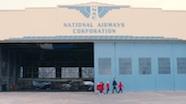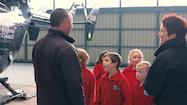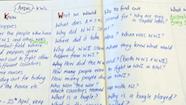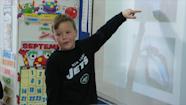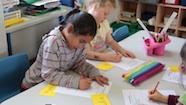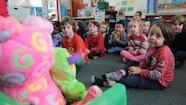Andrea Robertson and Lisa Hocking share how mathematics and science were incorporated into their technology learning.
Technology, mathematics, and science in years 3–4: Flight inquiry
Transcript
Andrea Robertson: We had some assessment in maths and then from that, we identified that measurement was an area that needed some more work and so for our maths, we’ve split the children into different groups and are focusing on measurement and flight.
Lisa Hocking: Some of the maths we did was looking at the first flight and being 97 metres trying to bring that to life for children. So we went outside onto the field and we estimated 97 metres and the children used their bodies to do that, they had great ways to do it. Then we used trundler wheels and metre rulers to actually work out where 97 metres was and they worked out their distance, how close to that they were.
There was one dear wee poppet who was bang on, so well done to him! So from there, we looked at how long it took for that first flight and it was 20 seconds. We looked at what does 20 seconds feel like, and could we run at the speed of that first flight, would it be possible?
And the children drew on knowledge they already had about the 100 metre sprinters and they all knew about that and they thought, yeah we can do it in 20 seconds so off they set and sure enough, they were pretty bang on at a child’s sprinting rate running 97 metres in the 20 seconds and getting a concept of, actually that first flight wasn’t very fast and haven’t we come a long way in technology?
We also did a timeline and looking at the history of flight. The maths in that was looking at four digit numbers and ordering four digit numbers with a purpose and so in groups, they had flight cards and sequenced them but at the same time, there was that technology focus there.
So we’ve gone right up to 2002 and our next thing is to look at drones and add those onto the timeline. For science, we were looking at the physics of flight and there was a natural progression from our airport visits. As a tuning in to our inquiry as well, we used our discovery time syndicate-wide and had many activities set up for the children to do and so we got out sycamore seeds and they tossed those in the air, they made paper roto-copters, they dragged plastic bags around behind them on a very windy day, the weather definitely cooperated with us on that day and the kids had an absolute ball racing around outside.
The children made paper planes and threw those around during discovery time. We also had balloons and hair dryers, and just showing the effects of air, and air pressure, and airflow for children because air is all around us but unless we actually explore that, to children, that’s lost. Tech practice when children are making things like the circle gliders or the kites does require fair testing, so the nature of science really comes play. So we got the children to test a basic design and then identify variables and choose only one to change and to measure. So they trialled and measured, trialled again, made adaptations, trialled again. Tested, recorded using metres and centimetres, their flights, yeah metres for the good ones and centimetres for the others.
Related videos
Technology and literacy in years 3–4: Flight inquiry (04:56)
Andrea Robertson describes the richness of their "amazing flight inquiry" – incorporating EOTC and learning in technology, literacy, and numeracy. ...
Technology flight inquiry: EOTC in our community (04:27)
Dean Gordon shares how visits within the local community created understanding of the made and natural worlds.
Technology as a part of a cross-curriculum inquiry (04:52)
Anne Bunton explains how the technology learning area gave purpose to a class project.
Cars are technological outcomes (03:53)
James Mawson explores cars as technological outcomes with his year 2 class.
Year 1–2 technologists design for a purpose (03:52)
Students in years 1 and 2 discuss with their teacher why technologists make things out of different materials.
Year 1–2 future technologists (02:06)
Kathy Chandler and her year 1–2 students discuss technological outcomes and what technologists do.
New entrants identify the made world (03:14)
New entrants explore what technology is with teacher Jill Harper.

